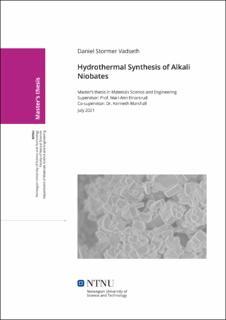| dc.contributor.advisor | Einarsrud, Mari-Ann | |
| dc.contributor.advisor | Marshall, Kenneth | |
| dc.contributor.author | Vadseth, Daniel Stormer | |
| dc.date.accessioned | 2021-09-30T16:25:41Z | |
| dc.date.available | 2021-09-30T16:25:41Z | |
| dc.date.issued | 2021 | |
| dc.identifier | no.ntnu:inspera:80234703:25575588 | |
| dc.identifier.uri | https://hdl.handle.net/11250/2786773 | |
| dc.description.abstract | Reaksjonsforholdene under hydrotermal syntese av kalium- og natriumniobater har blitt undersøkt med hensikt å forstå effekten av reaksjonsforholdene på kinetikken, faseformasjonen, morfologien og gitteparametrene. Kalium natrium niobat, K0.5Na0.5NbO3 (KNN), har blitt en mulig erstatning for bly zirkonat-titanat (PZT) som et piezoelektrisk material, spesielt for biomedisinske bruksområder. Kunnskap om reaktantene til KNN, kaliumniobat (KNbO3) og natriumniobat (NaNbO3), vil føre til bedre kontroll over dens egenskaper. Dette prosjektet har undersøkt den hydrotermale syntesen av (K, Na)NbO3og andre alkaliniobater laget med Nb2O5 og (K, Na)OH som reaktanter ved å variere synteseparametrene temperatur, alkalinitet, K:Nb molforhold, niobkonsentrasjon og valg avalkalimetall. Produktene fra den hydrotermale syntesen ble analysert med røntgendiffraksjon, Raman spektroskopi og elektronmikroskop for å undersøkekrystallografien, lokalstrukturen og morfologien til alkaliniobatene. Resultatene viser at valg av alkalimetall i tillegg til temperatur og alkalinitet er parametrene med størst påvirkning på reaksjonskinetikken til (K,Na)-Nb-O systemet. K:Nb molforholdet påvirket også reaksjonskinetikken, større K:Nb molforhold førte til syntese av KNbO3 ved lavere KOH konsentrasjoner. Større K:Nb molforhold førte også til syntese av monoklinisk KNbO3 ved temperaturer på 200°C og lavere, som ikke er demonstrert i litteraturen når Nb2O5 er brukt som reaktant. Forskjellen med bruk av kalium og natrium på deres respektive alkaliniobater er at natriumniobatene hadde raskere reaksjonkinetikk og mer uniform morfologi iforhold til kaliumniobatene. Kaliumniobatene viste større grad av agglomerasjon, noe natriumniobatene ikke viste. Gitterparametrene til (K, Na)NbO3 viste at gitterkonstantene a og c var tilnærmet like ved lavere temperatur og divergerte ettersom temperaturen økte. Β vinkelen i de monokliniske KNbO3 materialene varierte mellom 89.9 og 90.1°og tilnærmet seg 90° ved høyere temperaturer. Andre alkaliniobater enn (K, Na)NbO3, som K8−xHxNb6O19·nH2O (x=0-3,n=10, 13,16), K2Nb2O6·H2O, K4Nb6O17, og Na2Nb2O6·H2O, ble også syntetisert. K2Nb2O6·H2O hadde fiber morfologi, mens K4Nb6O17 hadde nanoplate morfologi. Bedre forståelse av kalium- og natriumniobat systemene er nok et steg mot miljøvennlige og billige piezoelektriske materialer. Oppdagelsen av synteseforholdene som fører til dannelse av monoklinisk KNbO3 som bruker Nb2O5 som reaktant istedenfor metallisk niob pulver er et viktig steg mot kommersielt tilgjengelige funksjonelle kaliumniobater. | |
| dc.description.abstract | The hydrothermal synthesis conditions of potassium and sodium niobates were investigated with the intention of understanding the effect of synthesis conditions on the reaction kinetics, phase formation, morphology and lattice parameters. Potassium sodium niobate, K0.5Na0.5NbO3 (KNN), has become a contender for the state of the art material lead zirconate-titanate as a piezoelectric material. To understand and improve the properties of KNN it is important to understand potassium niobate, KNbO3, and sodium niobate, NaNbO3, its precursors. This work aims to investigate the hydrothermal synthesis of the (K,Na)NbO3 and other alkali niobate phases made using Nb2O5 and (K,Na)OH as precursors and by changing synthesis conditions such as temperature, alkalinity, K:Nb molar ratio, niobium concentration and choice of alkali metal. The samples were analyzed using X-ray diffraction, Raman spectroscopy and scanning electron microscopy to determine the crystallographic structure, local structure and morphology. The results show that the choice of alkali metal as well as higher temperatures and alkalinity are the main factors increasing the reaction kinetics of the (K,Na)-Nb-O system. K:Nb molar ratio affected reaction kinetics as well, as higher K:Nb molar ratio lead to KNbO3 being synthesized at lower pH. Higher K:Nb molar ratio also made the synthesis of monoclinic KNbO3 at temperatures 200°C and below possible, which has not previously been demonstrated in literature when usingNb2O5 as the precursor. Regarding the differences between the alkali metals and their respective niobates, it was found that sodium niobates had faster reaction kinetics and uniform morphology compared to potassium niobates. Potassium niobates showed high degree of agglomeration while sodium niobates did not. Lattice parameters of all (K, Na)NbO3 samples showed that the a and c lattice constants were similar at lower temperatures and deviated at higher temperatures. The β angle of the monoclinic KNbO3 was between 89.9 and 90.1° and approached 90° at higher temperatures. Other niobate phases such as K8−xHxNb6O19·nH2O (x=0-3, n=10, 13, 16), K2Nb2O6·H2O, K4Nb6O17, and Na2Nb2O6·H2O were synthesized and analyzed along with the (K, Na)NbO3. K2Nb2O6·H2O and K4Nb6O17 had fiber and nanoplate morphology respectively. The improved understanding of the potassium and sodium niobate systems is another step towards environmentally friendly and cheap piezoelectric materials. The discovery of synthesis conditions that can produce monoclinic KNbO3 using Nb2O5 as the precursor instead of metallic niobium powder is a key development towards commercially viable functional potassium niobates. | |
| dc.language | eng | |
| dc.publisher | NTNU | |
| dc.title | Hydrothermal Synthesis of Alkali Niobates | |
| dc.type | Master thesis | |
